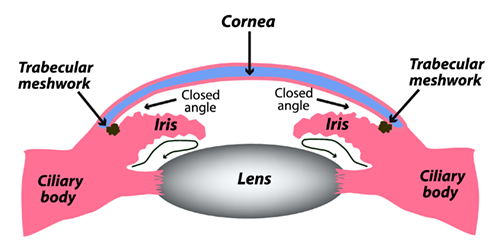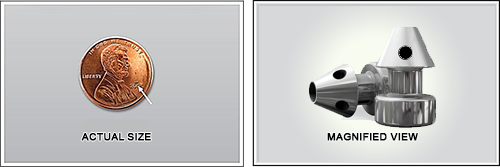Glaucoma Management
Protecting Eye Health, Preventing Vision Loss

Glaucoma is the second leading cause of blindness. Sometimes called the silent thief of sight, glaucoma damages your vision so gradually you don’t notice any loss of vision until the disease is at an advanced stage. There are no symptoms, until it’s too late. Glaucoma is a condition when fluid cannot flow easily through the eye, causing pressure to build. This increase in pressure, called intraocular pressure, can damage the optic nerve. If damage to the optic nerve from high eye pressure is allowed to continue unchecked, glaucoma will cause loss of vision. Without treatment, glaucoma can cause permanent blindness within a few years.
Because most people with glaucoma have no early symptoms or pain from this increased pressure, it is important to have regular eye exams so that glaucoma is properly diagnosed and treated before any visual loss occurs.
Two Types of Glaucoma:
Open-Angle Glaucoma

This is the most common type of glaucoma. The structures of the eye appear normal, but fluid in the eye does not flow properly through the drain of the eye, called the trabecular meshwork.
Angle-Closure Glaucoma

This type of glaucoma is less common, but can cause a sudden buildup of pressure in the eye. Drainage may be poor because the angle between the iris and the cornea (where a drainage channel for the eye is located) is too narrow. Or, the pupil opens too wide, narrowing the angle and blocking the flow of the fluid through that channel.
Your doctor will be able to diagnose the type of glaucoma and the actual severity of the intraocular pressure. Treatment options vary from drops to surgery, depending on the type and severity of your condition.
Glaucoma Medications
Glaucoma is typically treated with eye drops that decrease eye pressure either by slowing the amount of fluid produced within the eye or by improving the flow through the drainage angle. Glaucoma medications may have side effects, so be sure to talk to your doctor if you experience any unusual symptoms.
Glaucoma Surgery
SLT – Selective Laser Trabeculoplasty

Selective Laser Trabeculoplasty (SLT) offers a new glimpse of hope for glaucoma patients. By engaging this laser technology, ophthalmologists can now lower pressure that may help a patient avoid more invasive surgery. SLT can also reduce dependence on drops.
SLT uses short pulses of low-energy laser light to target melanin-containing cells in a network of tiny channels, called the trabecular meshwork. The objective of the surgery is to help fluids move through the drainage channels of the eye, reducing intraocular pressure that damages the optic nerve, causing loss of vision.
iStent
The iStent® Trabecular Micro-Bypass Stent is FDA-approved for use in conjunction with cataract surgery to reduce eye pressure in adults with mild-to-moderate open-angle glaucoma currently being treated with glaucoma medicine. iStent works like stents used to prevent heart attacks and strokes. When blood vessels get clogged, a stent creates access to the vessel flow. This highly innovative technology is elegantly simple:
- If you have glaucoma, over time the eye’s natural drainage system becomes clogged.
- iStent creates a permanent opening through the blockage to improve the eye’s natural outflow.
- Restoring this mechanism lowers and controls pressure within the eye.
Managing Glaucoma While Treating Cataracts
If required, Dr. Hayden will implant an iStent during your cataract surgery procedure. Once implanted, iStent will begin working to safely and effectively manage pressure. What’s more, patients who receive iStent may experience a reduction in glaucoma medications. This is important because once diagnosed, most patients will spend the rest of their lives putting one, two or even three different kinds of drops in every day. Most patients would prefer and option to these inconvenient, expensive drops, and iStent is a promising option.
World’s Smallest Medical Implant, Delivers Big Results in Open-Angle Glaucoma
While mild-to-moderate open-angle glaucoma is very common, many people are unaware of their condition, especially in the early stages, when their vision may be unaffected. In many people, open-angle glaucoma is characterized by an increase in the intraocular pressure (IOP) of your eye. This pressure is caused by the buildup of fluid within the eye. Too much fluid raises pressure, which can cause the gradual loss of vision. And while glaucoma moves slowly, its damage is irreparable.

The iStent is 20,000 times smaller than the intraocular lenses (IOL) used in your cataract surgery. In fact, it’s the world’s tiniest medical device! In a U.S. clinical trial, 68% of glaucoma patients who received iStent remained medication free at 12 months while sustaining a target IOP of = 21 mm Hg vs. only 50% of patients who underwent cataract surgery alone.
Trabeculectomy and Glaucoma
Trabeculectomy and glaucoma tube placement are surgical procedures performed to lower eye pressure. By trying to lower the eye pressure, future damage can be halted, but damage already done is not reversible. The procedure involves Dr. Hayden creating a tiny passage way from the inside to the outside of your eye. This improves drainage. Trabeculectomy can lower the pressure in your eye and help prevent more damage to the optic nerve. It is used after other treatment options have not been successful or are simply not reducing your intraocular pressure. Dr. Hayden may consider this option if:
- Medicines do not work as planned
- Laser surgery to lower the eye pressure has not worked

